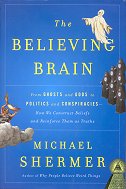Synthesizing thirty years of research, psychologist and science historian Michael Shermer
upends traditional thinking about how humans form beliefs about the world.
Simply put, beliefs come first, and explanations for beliefs follow.
The brain, Shermer argues, is a belief engine.
Using sensory data that flow in through the senses,
the brain naturally looks for and finds patterns—and
then infuses those patterns with meaning, forming beliefs.
Once beliefs are formed, our brains subconsciously seek out confirmatory evidence
in support of those beliefs, accelerating the process of reinforcing them—and
round and round the process goes in a positive feedback loop.
In The Believing Brain, Shermer provides countless real-world examples of how this process operates, from politics, economics, and religion to conspiracy theories, the supernatural, and the paranormal. And ultimately he demonstrates why science is the best tool ever devised to determine whether or not our beliefs match reality.
